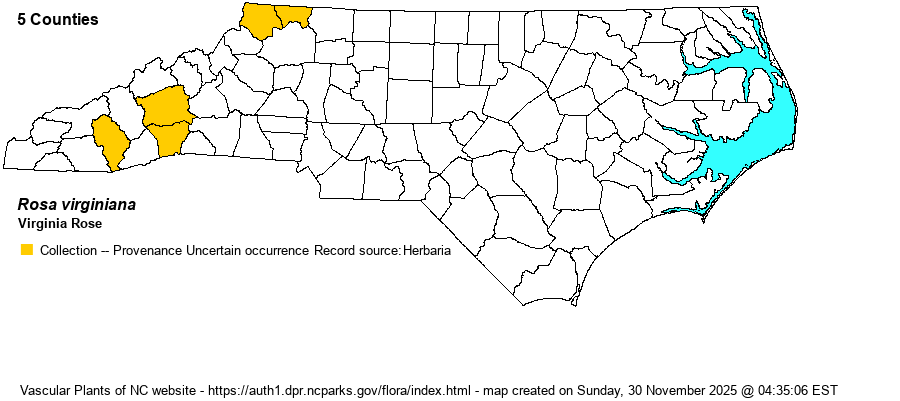| Author | P. Miller | |
| Distribution | Very poorly known, as it can be quite difficult to identify. Only known from a few historical records in the Mountains. The SERNEC database has collection records from across the state, but nearly all of these are identification errors or escapes. The Virginia Digital Atlas shows only a single county record – Fairfax in the far northern Piedmont -- but this specimen was annotated to R. canina in 2011 by W.H. Lewis. B.A. Sorrie has seen 2 specimens that appear to be correctly identified: Ashe Co., alder thicket, 4 mi. NE of Jefferson, 5 July 1952, Radford 6228 (NCU); Buncombe Co., dry open woods, Biltmore, 11 June 1897, Biltmore 855b (NCU). Both were annotated as virginiana by W.H. Lewis in 2011, but he also wrote "introduced" on the sheets, no doubt due to the locations as disjunct from farther north. In addition, Weakley (2024) does not include it as occurring in NC or TN, showing just "?" in the NC Piedmont, and in VA is has been reliably collected only in the far north (Fairfax County). Thus, any NC occurrences -- if indeed correct, should be considered as provenance uncertain.
This species has an unusual overall range, presuming correct identification. Though it occurs in eastern Canada, it has a narrow range southward only through East Coast states to northern VA (southward likely escapes). There are few records for OH and KY and states to the west, perhaps mostly erroneous.
| |
| Abundance | Extremely rare, or rare and easily overlooked, and not even currently known from the state; of historical occurrence. This is a NC Significantly Rare species. Based on Weakley (2022), the website editors suggest a rank of SE? (State Exotic?). | |
| Habitat | This species, at least in the southeastern part of the range, seems to favor damp sunny thickets. Specimen labels in NC include "Near spring head of ravine", "Alder thicket", "moist soil near branch", and "Open, moist shrub thicket in clearing". However, another record from the Mountains states "Dry, open woods". |
| Phenology | Blooms mainly in May and June, and fruits from August to October. | |
| Identification | Essentially no biologists are familiar with species in the state, and as it can be confused with other roses, it is understandable that there are few state records. The species is very similar to Carolina Rose and has been lumped under that species or under Swamp Rose (R. palustris) in several references that fail to include the species. Gleason (1952) says the species is easily confused with R. carolina. However, it is a bushy shrub averaging 4-6 feet tall, with broad curving thorns. Though there are one or more exotic rose species that may fit that description, any montane rose growing over 3 feet tall in meadows -– damp or dry -- should be examined for this very rare species (in the central Atlantic). | |
| Taxonomic Comments | Confused, at least in the past, even though Fernald (1950) and Gleason (1952) considered it a valid species. RAB (1968) lists Rosa virginiana as an alternate or old name for R. palustris, certainly in error. There are no subspecies or varieties listed for it.
| |
| Other Common Name(s) | Common Wild Rose, Prairie Rose (used also for other species) | |
| State Rank | SH [SE?] | |
| Global Rank | G5 | |
| State Status | SR-P | |
| US Status | | |
| USACE-agcp | FAC link |
| USACE-emp | FAC link |

